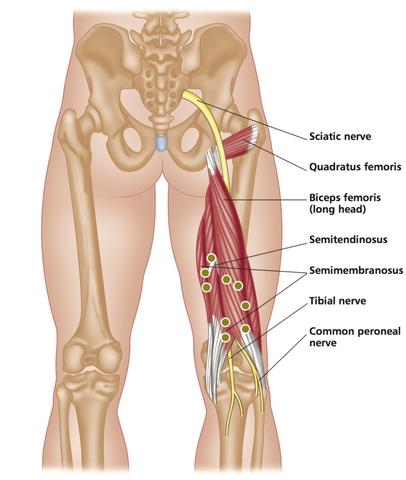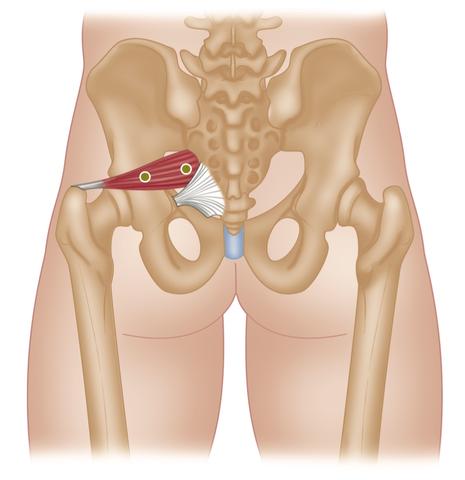Trigger Point Therapy - Sciatica Overview
Piriformis Syndrome - Stuart Hinds
Sciatica is not a diagnosis in itself, it is rather a symptom of an underlying problem
Sciatica is an umbrella term given to any sort of pain that is caused by irritation or compression of the sciatic nerve; this can include leg pain, sometimes accompanied by tingling, numbness, or weakness.
Typically the pain originates in the lower back and travels through the buttock and down the large sciatic nerve behind the thigh and radiates down below the knee.

The Sciatic Nerve
The sciatic nerve is the largest single nerve in the body and is made up of individual nerve roots that branch out from the spine starting at L3—these combine to form the sciatic nerve.
The nerve then branches out in each leg to supply the various parts of the leg (thigh, calf, foot, toes, etc.).
Types of Sciatica
It is important to differentiate what “type” of sciatica the client is suffering from.
Axial sciatica (where the nerve root is impinged at the lumbar spine) and appendicular sciatica (where the nerve entrapment is elsewhere in the nerve, not in the nerve roots) need slightly different treatments.
Disc Disease and Degeneration
One of the common causes of sciatica is a herniated disc (also known as a slipped or prolapsed disc); this puts pressure on the nerve causing the sciatica symptoms (an axial sciatica).
This is not, however, the only cause; the incidence of sciatica increases with age owing to two age-related conditions: degenerative disc disease, which irritates a nerve root and causes sciatica, and lumbar spinal stenosis, which causes sciatica due to a narrowing of the spinal canal.

Piriformis - Common Trigger Point Sites
Piriformis Syndrome
Piriformis syndrome is also a common cause of sciatic pain, where the sciatic nerve is compressed by the piriformis muscle.
There are a number of reasons why this can happen. If it is as a result of a new trauma or injury, then the client should see their medical practitioner to check this is not something that needs immediate attention.
In the majority of these cases it is likely that the piriformis muscle has simply become too tight and this puts pressure on the sciatic nerve giving the symptoms of sciatica.
This is often a result of trigger points in the piriformis which cause the muscle to become tighter, shorter, and less efficient.
Where the sciatica arises from piriformis syndrome, the symptoms will usually become worse after prolonged sitting, walking, or running but may feel better after lying down on the back.

Stretching Exercises for Piriformis are simple to perform and can be beneficial
Other Causes
Other, more rare, causes can include irritation of the nerve from adjacent bone, tumors, muscle tightness, internal bleeding, infections, injury, and, for some women, pregnancy.
Nerve entrapment by the piriformis muscle is probably the most common cause of appendicular sciatica, accounting for up to 70% of these cases, and there are simple tests that can be done to establish if this is the case.
As ever, if your client is in any doubt a medical opinion should be sought.
Appendicular sciatica is characterized by increased pain from sitting, walking up stairs or inclines, the direct pressure of sexual intercourse in women, or with resisted active external rotation of the femur.
Common Testing Method
This can be tested by asking your client to sit toward the edge of a chair and lift the leg of the affected side with the knee bent, as far toward the chest as is comfortable.
If this increases the pain it indicates that the problem is more likely to be in the piriformis, or possibly the hamstrings.
When this is the case then deeper work is indicated in order to release the muscle tension that is putting pressure on the nerve.

Gluteus Maximus - Common Trigger Point Sites
Trigger Points and Sciatica
In summary, whilst there are those cases of sciatica which require more aggressive intervention to deal with the underlying cause, the preferred and most effective treatment in most cases is manual therapy including trigger point therapy, combined with prescribed stretching and strengthening exercises.
The trigger points commonly (almost always) associated with sciatica are found in the piriformis and gluteal muscles.
It's worth mentioning that Dr. Travell referred to the gluteus minimus as the “Psuedo-Sciatica” muscle because its trigger points can refer pain that mimic the symptoms associated with true neurological sciatica.
This trigger point therapy blog is intended to be used for information purposes only and is not intended to be used for medical diagnosis or treatment or to substitute for a medical diagnosis and/or treatment rendered or prescribed by a physician or competent healthcare professional. This information is designed as educational material, but should not be taken as a recommendation for treatment of any particular person or patient. Always consult your physician if you think you need treatment or if you feel unwell.

Continuing Professional Education
Looking for Massage Therapy CEUs, PT and ATC continuing education, chiropractic CE, or advanced manual therapy training? Explore our evidence-based online courses designed for hands-on professionals.



















